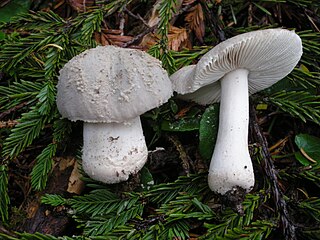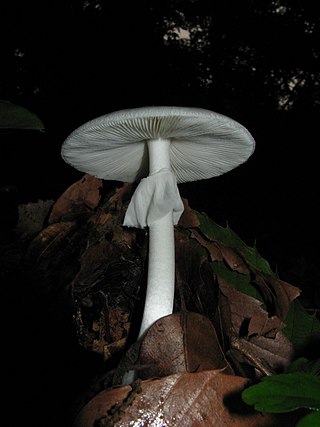
The genus Amanita contains about 600 species of agarics, including some of the most toxic known mushrooms found worldwide, as well as some well-regarded edible species. The genus is responsible for approximately 95% of fatalities resulting from mushroom poisoning, with the death cap accounting for about 50% on its own. The most potent toxin present in these mushrooms is α-Amanitin.

The Amanitaceae is a family of mushroom-forming fungi. Amanita Pers. is one of the most speciose and best-known fungal genera. The family, also commonly called the amanita family, is in order Agaricales, the gilled mushrooms. The family consists primarily of the large genus Amanita, but also includes the smaller genera Amarrendia, Catatrama, Limacella, Limacellopsis, Saproamanita, Torrendia and Zhuliangomyces. Both Amarrendia and Torrendia are considered to be synonymous with Amanita but appear quite different because they are secotioid.

Amanita citrina, commonly known as the false death cap or citron amanita, is a basidiomycotic mushroom, one of many in the genus Amanita. It grows in silicate soil in the summer and autumn months. It bears a pale yellow or sometimes white cap, with white stem, ring and volva. Though not deadly, it is inedible and often confused for the lethal death cap.

Amanita farinosa, commonly known as the Eastern American floury amanita or the American floury amanita, is a North American poisonous mushroom of the genus Amanita, a genus of fungi including some of the most deadly mushrooms.

Amanita verna, commonly known as the fool's mushroom or the spring destroying angel, is a deadly poisonous basidiomycete fungus, one of many in the genus Amanita. Occurring in Europe in spring, A. verna associates with various deciduous and coniferous trees. The caps, stipes and gills are all white in colour.

Amanita subjunquillea, also known as the East Asian death cap is a mushroom of the large genus Amanita, which occurs in East and Southeast Asia. Potentially deadly if ingested, it is closely related to the death cap A. phalloides.

Amanita arocheae, also known as the Latin American death cap, is a mushroom of the large genus Amanita, which occurs in Colombia, Central America and South America. Deadly poisonous, it is a member of section Phalloideae and related to the death cap, A. phalloides.

The European white egg, bearded amanita or European egg amidella, is a species of fungus of the genus Amanita in the family Amanitaceae. It is a large, white-colored fungus, often tinged with cream. Native to Europe, it is found on plains as well as mountains in the Mediterranean region. It is similar to some deadly poisonous species.

Amanita strobiliformis is a species of mushroom. It is commonly referred to as warted amanita.

Amanita exitialis, also known as the Guangzhou destroying angel, is a deadly poisonous mushroom of the large genus Amanita. The fruit bodies (mushrooms) are white, small to medium-sized with caps up to 7 centimetres in diameter. It is a member of section Phalloideae and related to A. phalloides.
Amanita virosiformis, commonly known as the narrow-spored destroying angel, is a poisonous basidiomycete fungus, one of many in the genus Amanita. Originally described from Florida, it is found from coastal North Carolina through to eastern Texas in the southeastern United States.

Amanita magnivelaris, commonly known as the great felt skirt destroying angel or the great feltskirt destroying angel amanita, is a highly toxic basidiomycete fungus, one of many in the genus Amanita. Originally described from Ithaca, New York, by Charles Horton Peck, it is found in New York state and southeastern Canada.
Amanita elliptosperma, commonly known as the Atkinson's destroying angel, is a basidiomycete fungus, one of many in the genus Amanita. Although its toxicity is not confirmed, it is assumed to be deadly poisonous like its close relatives. Originally described from North Carolina, it is found in the eastern United States from New England to eastern Texas.

Amanita fuliginea, commonly known as the east Asian brown death cap, is a species of deadly poisonous mushroom in the family Amanitaceae. The fruit bodies have convex, dark gray to blackish caps measuring 3–6 cm (1.2–2.4 in) in diameter. The gills, largely free from attachment to the stipe, are white and have short gills (lamellulae) interspersed. The spores are roughly spherical, amyloid, and typically measure 8–11 by 7–9.5 µm. The species was described as new to science by Japanese mycologist Tsuguo Hongo in 1953. A. fuliginea is classified in Amanita section Phalloideae, which contains the infamous destroying angel.
Amanita subpallidorosea is a mushroom of the large genus Amanita, which occurs under oaks in southern China and Taiwan.
Amanita subfuliginea is a mushroom of the large genus Amanita, which occurs central and southern China. It is closely related to the east Asian death cap A. fuliginea.
Amanita griseorosea is a mushroom of the large genus Amanita, which occurs under beech in southern China. It is closely related to A. molliuscula.
Amanita molliuscula is a mushroom of the large genus Amanita, which occurs under beech in Shaanxi Province in China. It is closely related to A. griseorosea.
Amanita parviexitialis is a mushroom of the large genus Amanita, which occurs under beech in southern China.













